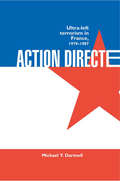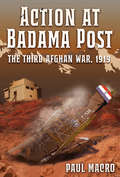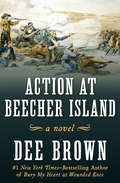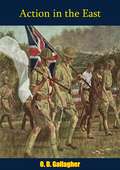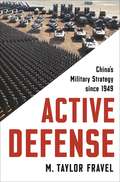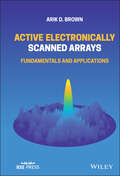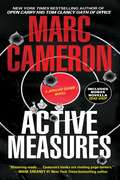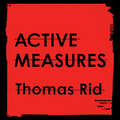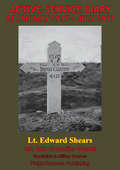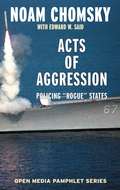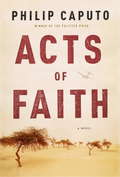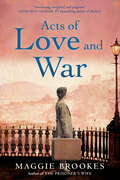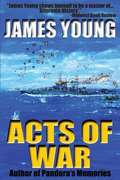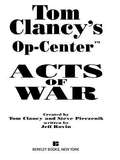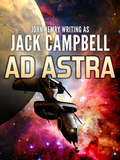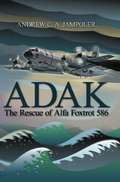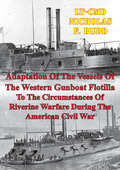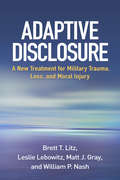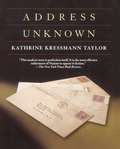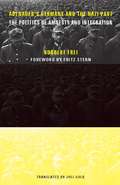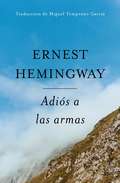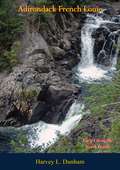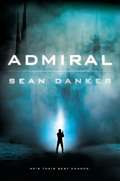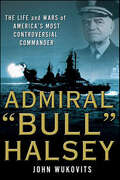- Table View
- List View
Action Directe: Ultra Left Terrorism in France 1979-1987
by Michael Y. DartnellIn defining Action Directe's mixture of millenarianism, workerism and nihilism, this study explains why the group turned to a strategy of murderous strikes and how a revolutionary political faction emerged in a stable western society.
Action at Badama Post: The Third Afghan War, 1919
by Paul MacroA thrilling account of the rescue of RAF crewmen after their aircraft crashes in Afghanistan in 1919. This is the story of an unknown incident during the little-known Third Afghan War. An aircraft from the No. 20 Squadron RAF was lost while investigating gathering tribesman. The crew were rescued, and most of the aircraft was recovered by the Kurram Militia and the 22nd Battery Motor Machine Gun Service. It was an all-arms action—the lives of two airmen were saved at the cost of an Indian Militiaman and an unknown number of Afghan tribesmen. It also illustrates the experience of a virtually unknown group of soldiers, the 22nd Battery of the Motor Machine Gun Service. They had volunteered to serve as Motor Machine Gunners in France, had been through an intense, competitive, and sometimes costly selection process, and had now suddenly found themselves dispatched half way round the globe to the heat, dust, snows and monsoons of India and the North-West Frontier. This book examines the conflict’s background, the Kurram Militia, the history of the squadron and the lives of the key players. While this was not the only action the 22nd Battery of the Motor Machine Gun Service fought during the Third Afghan War, this one was recorded in the account of A/Sjt Ernest “Bill” Macro, who was in charge of the section of 22nd Battery dispatched to Badama Post in late July 1919. This is his story, and the stories of the other men for whom the climax of their experience in the Third Afghan War came during the action at Badama Post
Action at Beecher Island: A Novel
by Dee BrownA gripping recreation of a notoriously bloody clash between US Army scouts and American Indian warriors, by the #1 New York Times–bestselling author. Historian Dee Brown dramatically recounts the nine-day siege between Plains tribes and Major James William Forsyth&’s scouts. Based on historical sources, the novel is told from a variety of viewpoints, including that of Lieutenant Frederick Beecher, still wounded from the Civil War and charged with clearing out American Indian settlements to make way for the Kansas Pacific Railroad. Beecher is joined by General Sheridan and Major Forsyth, as well as the scouts—from seasoned frontiersmen to young boys—employed to take part in the perilous mission. On the other side are the famous American Indian players in the battle: Turkey Leg and Roman Nose. With this complex assortment of characters, Brown vividly recreates the 1868 siege, as well as the competing worldviews of life on the prairies. This ebook features an illustrated biography of Dee Brown including rare photos from the author&’s personal collection.
Action in the East
by O. D. GallagherThis book, first published during WWII in 1942, is reporter O'Dowd Gallagher's account of nine eventful months in southeastern Asia. During his stay in Singapore, the Japanese bought to fruition their carefully conceived plan for striking simultaneously at Pearl Harbor, Malaya, Hong Kong, the Philippines, and the Netherlands Indies.An absorbing first-hand record of the brutal opening phases of the Second World War in the Far East.
Active Defense: China's Military Strategy since 1949 (Princeton Studies in International History and Politics #167)
by M. Taylor FravelWhat changes in China’s modern military policy reveal about military organizations and strategySince the 1949 Communist Revolution, China has devised nine different military strategies, which the People’s Liberation Army (PLA) calls “strategic guidelines.” What accounts for these numerous changes? Active Defense offers the first systematic look at China’s military strategy from the mid-twentieth century to today. Exploring the range and intensity of threats that China has faced, M. Taylor Fravel illuminates the nation’s past and present military goals and how China sought to achieve them, and offers a rich set of cases for deepening the study of change in military organizations.Drawing from diverse Chinese-language sources, including memoirs of leading generals, military histories, and document collections that have become available only in the last two decades, Fravel shows why transformations in military strategy were pursued at certain times and not others. He focuses on the military strategies adopted in 1956, 1980, and 1993—when the PLA was attempting to wage war in a new kind of way—to show that China has pursued major change in its strategic guidelines when there has been a significant shift in the conduct of warfare in the international system and when China’s Communist Party has been united.Delving into the security threats China has faced over the last seven decades, Active Defense offers a detailed investigation into how and why states alter their defense policies.
Active Electronically Scanned Arrays: Fundamentals and Applications (IEEE Press)
by Arik D. BrownIn Active Electronically Scanned Arrays: Fundamentals and Applications, electromagnetics expert Dr. Arik D. Brown delivers a foundational treatment of active electronically scanned arrays (AESAs) ideal for engineering students and professionals. The distinguished author provides an overview of the primary subsystems of an AESA and detailed explanations of key design concepts and fundamentals for subsystems, including antenna array elements, transmit/receive modules, and beamformers. Performance results for various AESA architectures often found in industry, including analog, subarrayed, and digital beamforming AESAs, are discussed. With a focus on practical knowledge and applications, Active Electronically Scanned Arrays: Fundamentals and Applications offers an accessible overview of a technology critical to the implementation of collision avoidance in cars, air surveillance radar, communication antennas, and defense technologies. The book also includes: A thorough introduction to AESAs, including a top-level block diagram view and explanations of key components and subsystems Detailed explanations of the impact of AESAs on mission applications including Radar, Electronic Attack (EA), Electronic Support Measures (ESM), SIGINT and Communications Comprehensive explorations of antenna array elements, transmit/receive modules, and beamformers including their purpose, functions, and practical design considerations In-depth examinations of AESA architecture performance for current and future systems Utility of AESAs for implementing adaptive beamforming for Electronic Counter-Countermeasures (ECCM) Perfect for electrical engineers working with active electronically scanned arrays, electronic warfare technologies, radar, or communications, Active Electronically Scanned Arrays: Fundamentals and Applications will also prove to be an invaluable resource for defense students undertaking military education and training.
Active Measures (A Jericho Quinn Thriller #8)
by Marc CameronOLD ENEMIES NEVER DIE Cuba and the United States are in talks to normalize relations, something the old guard on the Communist-controlled island has vowed to stop—by any means necessary. Zayda de la Guardia, a rogue general in the Cuban security services, has gotten his hands on a nuclear weapon left over from the Cold War. He plans to launch it on Miami, an attack that could kill millions. There&’s just one thing standing in his way: special agent Jericho Quinn and his team have traveled undercover to Cuba to unravel de la Guardia&’s plot before it ignites a nuclear holocaust. Thrown into a secret prison, pursued by assassins, and trapped on the tiny island during one of the worst hurricanes of the century, Quinn and his crew must survive a trial by fire to prevent an international confrontation that would make the Cuban Missile Crisis look like a fist fight. Praise for Marc Cameron&’s Open Carry &“Cameron, who has nearly three decades in law enforcement and a stint as a U.S. Marshal, keeps all the plot points delicately balanced and at the same time creates sympathetic heroes, depraved villains, and nail-biting action. Readers will eagerly await his next.&”—Publishers Weekly,STARRED REVIEW &“Cameron effectively combines investigation and straight-ahead action . . . a compelling, never-give-an-inch hero who will appeal to Jack Reacher fans.&”—Booklist
Active Measures: A History of Disinformation
by Thomas RidWe live in an age of organized deception. Spy agencies pour vast resources into hacking, leaking, and forging data, often with the goal of weakening the very foundation of liberal democracy: trust in facts. Thomas Rid, a renowned expert on technology and national security, was one of the first to sound the alarm. Even before the 2016 election, he warned that Russian military intelligence was "carefully planning and timing a high-stakes political campaign" to disrupt the democratic process. But as crafty as such so-called active measures have become, they are not new.In this astonishing journey through a century of secret psychological war, Rid reveals for the first time some of history's most significant operations - many of them nearly beyond belief. A White Russian ploy backfires and brings down a New York police commissioner; a KGB-engineered, anti-Semitic hate campaign creeps back across the Berlin Wall; the CIA backs a fake publishing empire, run by a former Wehrmacht Uboat commander that produces Germany's best jazz magazine.Rid tracks the rise of leaking, and shows how spies began to exploit emerging internet culture many years before WikiLeaks. Finally, he sheds new light on the 2016 US election, especially the role of the infamous "troll farm" in St. Petersburg, as well as a much more harmful attack that unfolded in the shadows. We live in strange times. Only the perverse logic of active measures can explain them.
Active-Service Diary - 21 January 1917-1 July 1917
by Lieutenant Edward Hornby ShearsThe short, but poignant and action filled diary of a public school officer who fought with the Irish Guards in the Ypres Salient.EDWARD HORNBY SHEARS was born in Liverpool On December 4, 1890. His preparatory school was The Leas, Hoylake (1900-1904). In July, 1904, he obtained a Foundation Scholarship at Bradfield, and in December 1908 a History Exhibition at Trinity College, Oxford. He went up to Oxford in October, 1909, and obtained a 'second' in 'Mods' in 1910, and a 'first' in 'Greats' in 1913. In September, 1913, he passed into the Home Civil Service, and was appointed to the Secretaries' Department of the General Post Office. A year later (October, 1914) he became Principal Private Secretary to the Postmaster-General, Mr. (now Sir Charles) Hobhouse. He had been refused official permission to join the army at the outbreak of the War, but he received it in May, 1915, and obtained a commission in the 3/4th Queen's (Royal West Surrey) Regiment. A few months later he was promoted to lieutenant. After training for a year and a half in England, and having no apparent prospect of being sent to the front, he obtained a transfer to the Irish Guards, in which he received his commission as ensign in November, 1916. In January, 1917, he joined the 1st Battalion in France, where he was shortly promoted to lieutenant (dating from October 18, 1916). He was killed in action at Boesinghe on July 4, 1917, and on the following day he was buried at Canada Farm, Elverdinghe, near Ypres.
Acts of Aggression: Policing Rogue States (Open Media Series #No. 13)
by Noam Chomsky Edward W. Said Ramsey ClarkIn Acts of Aggression three distinguished activist scholars examine the background and ramifications of the U.S. conflict with Iraq. Through three separate essays, the pamphlet provides an in-depth analysis of U.S./Arab relations, the contradictions and consequences of U.S. foreign policy toward "rogue states," and how hostile American actions abroad conflict with UN resolutions and international law.
Acts of Faith
by Philip CaputoThirty years ago, Pulitzer Prize-winning author and journalist Philip Caputo crossed the deserts of Sudan and Eritrea on foot and camelback, a journey that inspired his first novel, Horn of Africa,and awakened a lifelong fascination with Africa. His travels have since taken him back to Sudan, as well as to Kenya, Somalia, and Tanzania, and from those experiences he has fashioned Acts of Faith, his most ambitious novel. A stunning and timely epic, it tells the stories of pilots, aid workers, missionaries, and renegades struggling to relieve the misery wrought by the civil war in Sudan. The hearts of these men and women are in the right place, but as they plunge into a well of moral corruption for which they are ill-prepared, their hidden flaws conspire with circumstances to turn their strengths-bravery, compassion, daring, and empathy-into weaknesses. In pursuit of noble ends, they make ethical compromises; their altruism curdles into self-righteous zealotry and greed, entangling them in a web of conspiracies that leads, finally, to murder. A few, however, escape the moral trap and find redemption in the discovery that firm convictions can blind the best-intentioned man or woman to the difference between right and wrong. Douglas Braithwaite, an American aviator who flies food and medicine to Sudan's ravaged south, is torn between his altruism and powerful personal ambitions. His partners are Fitzhugh Martin, a multiracial Kenyan who sees Sudan as a cause that can give purpose to his directionless life, and Wesley Dare, a hard-bitten bush pilot who is not as cynical as he thinks he is and sacrifices all for the woman he loves. They are joined by two strong women: Quinette Hardin, an evangelical Christian from Iowa who liberates slaves captured by Arab raiders and who falls in love with a Sudanese rebel; and Diana Briggs, the daughter of a family with colonial roots in Africa, who believes that her love for her adopted continent might be enough to save it. Pitted against them is Ibrahim Idris ibn Nur-el-Din, a fierce Arab warlord whose obsessive quest for an escaped concubine undermines his faith in the holy war he is waging against Sudan's southern blacks. In a harsh yet alluring landscape, these and other vividly realized characters act out a drama of modern-day Africa. Grounded in the reality of today's headlines,Acts of Faith is a captivating novel of human complexity that combines seriousness with all the seductive pleasure of a masterly thriller.
Acts of Love and War
by Maggie BrookesA remarkable story of love and sacrifice centred on three young English volunteers in the bloody Spanish Civil War, from the author of The Prisoner's Wife.1936. Civil war is tearing Spain apart, and the world is on the brink of chaos... Twenty-one-year-old Lucy is frustrated with her constrained life in Hertfordshire, teaching and keeping house for her domineering father. But she is happy to be living next door to Tom and Jamie, two brothers she has known since childhood, and whom she loves equally. But everyone's lives are turned upside down when Tom, the younger, decides to join the Republican cause in the bloody war in Spain. His older, fervently Catholic brother Jamie soon follows--but as a reporter for the opposing forces that support General Franco in keeping Spain rigidly authoritarian, with the help of both Hitler and Mussolini. Lucy decides the only way to ensure the brothers' safety is to defy her father and travel to Spain herself and persuade them to come home. Yet when she sees the horrific effects of the war on the people--especially the children--she quickly joins the lifesaving work of the Quaker volunteers who have arrived from almost as many countries as have the International Brigades of fighters. Lucy knows that both brothers are in love with her; she herself is deeply torn between them. The atrocities and casualties mount and Lucy knows that the question of which man she might spend her life with might be irrelevent, as the chances of either of them surviving diminish with every passing day. This meticulously researched, deeply affecting novel is based on real memoirs of the Spanish Civil War. It is both a love story and a tribute to the remarkable women who fought with compassion and bravery to save the innocent victims of a war that was a foretaste of the carnage soon to come in World War II.
Acts of War (The Usurper's War Book #1)
by James YoungSomehow I doubt that this is quite how anyone expected Adolf Hitler's death to turn out. . . --Squadron Leader Adam Haynes, No. 303 (Polish) SquadronAugust 1942. London is in flames. Heinrich Himmler's Germany stands triumphant in the West, its "Most Dangerous Enemy" forced to the peace table by a hailstorm of nerve gas and incendiaries. With Adolf Hitler avenged and portions of the Royal Navy seized as war prizes, Nazi Germany casts its baleful gaze across the Atlantic towards an increasingly isolationist United States. With no causus belli, President Roosevelt must convince his fellow Americans that it is better to deal with a triumphant Germany now than to curse their children with the problem of a united, fascist Europe later. As Germany and Japan prepare to launch the next phase of the conflict, Fate forces normal men and women to make hard choices in hopes of securing a better future. For Adam Haynes, Londonfall means he must continue an odyssey that began in the skies over Spain. American naval officer Eric Cobb finds that neutrality is a far cry from safety. Finally, Rear Admiral Tamon Yamaguchi must prepare himself and his men to fight a Pacific War that is far different than the surprise attack Imperial Japan had once planned but never executed. Acts of War is the first novel of the Usurper's War series, which charts a very different World War II. As young men and women are forced to answer their nation's call, the choices they make and risks they take will write a different song for the Greatest Generation.
Acts of War: Op-Center 04 (Tom Clancy's Op-Center #4)
by Tom Clancy Steve Pieczenik Jeff RovinSyrian terrorists have attacked a dam inside the borders of Turkey, threatening the water supply of their very homeland. It is not insanity, but the first step in a deceptively simple plan: to force all-out war in the Middle East.<P> What they don't know is that a new Regional Op-Center is now on-line in Greece, and its team can see exactly what the rebels are trying to do. But these terrorists are more resourceful than anyone thinks.
Ad Astra (Short Stories Ser.)
by Jack CampbellFrom the author of the New York Times–bestselling Lost Fleet series comes 11 action-packed stories of space exploration.In Jack Campbell’s Lost Fleet series, Campbell’s hero Captain “Black Jack” Geary explores the furthest reaches of space. Here, Campbell explores what kinds of problems mankind might face as our horizons expand. The third in a series of collections of Campbell’s short stories includes some of Campbell’s favorite stories, and some of his earliest. A brand-new author’s note accompanies each story.“Lady Be Good” is one of Campbell’s most popular stories, winner of Analog magazine’s “AnLab” reader poll for Best Short Story and cited in Gardner Dozois’s Year’s Best SF. The Lady Be Good is an old ship, running obscure routes (not all on the right side of the law), with her loyal first officer Kilcannon and reclusive captain. When Kilcannon decides to rescue the survivors of an attack on a Vestral Company ship, a mysterious new passenger thanks him by asking difficult questions about the Lady, with unexpected answers.In “Kyrie Eleison,” the Verio shipwrecked centuries ago on an out-of-the-way planet, and the descendants of the ship’s survivors have gotten along as well as they can by following the orders that were passed on to them. But those orders weren’t intended to govern life on the planet’s surface, and when the Bellegrange arrives on a rescue mission, her captain will have to reckon with the unexpected social order on the planet.In “Do No Harm”, a ship is so technologically advanced that it can repair itself—but turning over the keys might not be the best idea. And in “Down the Rabbit Hole,” a series of failed attempts at faster-than-light travel lead to a novel approach: sending an untested Naval captain out in a space ship to see if he can figure out what’s gone wrong.With eleven stories in all, Ad Astra is the most multi-faceted introduction to the short fiction of Jack Campbell, and an essential complement to his bestselling book-length work.
Adak
by Andrew C. JampolerIn the tradition of great tales of men against the sea, this story offers a compelling look at courage and commitment in the face of certain tragedy. It is a powerful blend of human drama and real-life naval operations, but unlike most books in the genre, its heroes are airmen not seamen, and most survived their ordeal. Published on the twentieth-fifth anniversary of Alfa Foxtrot 586's fatal mission as a tribute to those lost, the account was written by a naval aviator who has flown the same aircraft on the same mission from the same air base. The aircraft is a P-3 Orion on station during a sensitive mission off the Kamchatka Peninsula in the north Pacific. The time is mid-day on 26 October 1978. Andy Jampoler takes readers into the cockpit of the turboprop as a propeller malfunction turns into an engine fire, eventually forcing Jerry Grigsby to ditch his patrol plane into the empty, mountainous seas west of the Aleutian Islands. His fourteen crewmembers, strapped in their seats, expect the worst--and get it. The aircraft goes down in just ninety seconds, taking one of the three rafts with it. A second raft, terribly overcrowded, soon begins to leak.The flight crew's desperate battle to survive is told with the authority, drama, and sensitivity that only someone with the author's background could provide. He draws on interviews with survivors, searchers, and even the master of the Soviet fishing trawler that saved the living and recovered the bodies of the dead. He also draws on recordings of radio communications, messages in the files of the state and defense departments, and the patrol squadron's own investigation of the ditching. Everyone who likes survival epics and enjoys reading sea and air adventures will be entertained by this engrossing true story.
Adam and Leonora: A Novel
by Carol JamesonAdam Sinclair is a reclusive surrealist painter, in search of his muse and obsessed with his visions, who lives in a vast artist&’s compound in the Santa Cruz mountains. Leonora Bloom is an artist and scientist who isn&’t sure why she is so drawn to a man she&’s never met yet can&’t shake her obsession with him. After years of hiking the ridge above Adam&’s property, she finally knocks on his door.Inside Adam&’s house, enormous paintings of golden spirals, cosmic stars, and cobalt universes cover the walls, vibrating with energy and mystery—and though he is aloof, the chemistry between him and Leonora is immediate. When the younger woman catches a glimpse of an old black-and-white photograph of his deceased wife, Pauline, who could be her twin, she begins to understand why. Interwoven with Leonora&’s tale are the voices of modern-day Don Quixote Adam&’s muses: Pauline, a talented writer who lives in both 1940s New York City and Mexico; and Mimi Saucier, a sultry singer from 1930s Paris. The two women play off characters of the Surrealist movement including André Breton, Remedios Varo, and Wolfgang Paalen, creating worlds of dreamy enchantment. Filled with intrigue and tension, secrets and admissions, and the colorful imagery of a painter&’s mind, Adam and Leonora explores Leonora&’s quest to discover Adam&’s secret to the creative pulse of life—a journey into the surreal.
Adaptation Of The Vessels Of The Western Gunboat Flotilla To The Circumstances Of Riverine Warfare: During The American Civil War
by Lt-Cmd Nicholas F. BuddThis study investigates the adaptation and purpose-built construction of the vessels used by the Federal government to conduct riverine warfare on the waters of the American Mississippi River drainage basin. The study concentrates on the technology, geography, hydrography, and convention which shaped the construction of the vessels comprising the Federal Western Gunboat Flotilla; an organization which after October 1862 became the United States Navy Mississippi Squadron.The ability of an organization to adapt is equipment to conditions encountered during wartime is often a contributing factor in ultimate victory or defeat. During the Civil War, the process adopted by the Navy to adapt and furnish vessels for its riverine force was flawed. This study emphasizes these facts and explores the response of the Navy chain of command to lessons learned in combat about the vulnerabilities of the vessels of the Western Gunboat Flotilla.The study is not intended as a treatise on tactics or the organization of the United States Navy. However, it does address both with regard to their effect on the performance and adaptation of the vessels of the Western Gunboat Flotilla.
Adaptive Disclosure: A New Treatment for Military Trauma, Loss, and Moral Injury
by Brett T. Litz Leslie Lebowitz Matt J. Gray William P. NashA complete guide to an innovative, research-based brief treatment specifically developed for service members and veterans, this book combines clinical wisdom and in-depth knowledge of military culture. <P><P>Adaptive disclosure is designed to help those struggling in the aftermath of traumatic war-zone experiences, including life threat, traumatic loss, and moral injury, the violation of closely held beliefs or codes. Detailed guidelines are provided for assessing clients and delivering individualized interventions that integrate emotion-focused experiential strategies with elements of cognitive-behavioral therapy (CBT). Reproducible handouts can be downloaded and printed in a convenient 8 1/2" x 11" size.
Address Unknown
by Kathrine Kressmann TaylorA rediscovered classic, originally published in 1938 --and now an international bestseller. When it first appeared in Story magazine in 1938, Address Unknown became an immediate social phenomenon and literary sensation. Published in book form a year later and banned in Nazi Germany, it garnered high praise in the United States and much of Europe. A series of fictional letters between a Jewish art dealer living in San Francisco and his former business partner, who has returned to Germany, Address Unknown is a haunting tale of enormous and enduring impact.
Adenauer's Germany and the Nazi Past: The Politics of Amnesty and Integration
by Norbert FreiOf all the aspects of recovery in postwar Germany perhaps none was as critical or as complicated as the matter of dealing with Nazi criminals, and, more broadly, with the Nazi past. While on the international stage German officials spoke with contrition of their nation's burden of guilt, at home questions of responsibility and retribution were not so clear. In this masterful examination of Germany under Adenauer, Norbert Frei shows that, beginning in 1949, the West German government dramatically reversed the denazification policies of the immediate postwar period and initiated a new "Vergangenheitspolitik," or "policy for the past," which has had enormous consequences reaching into the present. Adenauer's Germany and the Nazi Past chronicles how amnesty laws for Nazi officials were passed unanimously and civil servants who had been dismissed in 1945 were reinstated liberally—and how a massive popular outcry led to the release of war criminals who had been condemned by the Allies. These measures and movements represented more than just the rehabilitation of particular individuals. Frei argues that the amnesty process delegitimized the previous political expurgation administered by the Allies and, on a deeper level, served to satisfy the collective psychic needs of a society longing for a clean break with the unparalleled political and moral catastrophe it had undergone in the 1940s. Thus the era of Adenauer devolved into a scandal-ridden period of reintegration at any cost. Frei's work brilliantly and chillingly explores how the collective will of the German people, expressed through mass allegiance to new consensus-oriented democratic parties, cast off responsibility for the horrors of the war and Holocaust, effectively silencing engagement with the enormities of the Nazi past.
Adios a Las Armas (Spanish Edition)
by Ernest HemingwayUna inolvidable historia de amor entre una enfermera y un joven soldado idealista en la Italia de la I Guerra Mundial. Por el Premio Nobel de Literatura Ernest Hemingway.No amaba a Catherine Barkley, ni se le ocurría que pudiera amarla. Aquello era como el bridge, un juego donde te largas a hablar en vez de manejar las cartas. Eso pensaba el teniente americano Frederic Henry, conductor de ambulancias en el frente italiano durante la Primera Guerra Mundial, al poco de conocer a esta bella enfermera británica. Lo que parecía un juego se convirtió en pasión intensa, mientras la guerra lo arrasaba todo y los hombres desfilaban bajo la lluvia, agotados y hambrientos, sin pensar más que en huir de la muerte. Inspirada en las vivencias de Hemingway, Adiós a las armas es ya un clásico de la literatura universal y uno de los mejores retratos de la voluntad humana.
Adirondack French Louie: Early Life in the North Woods
by Harvey L. DunhamAlthough numerous books have been written about the Adirondacks and Adirondackers, not very many have become regional classics. Early authors such as John Todd, Charles Fenno Hoffman, Jeptha R. Simms, S. H. Hammond, J. T. Headly, Alfred B. Street, William H.H. Murray and Verplanck Colvin earned well-deserved popularity in their day and their literary output still exerts a potent appeal more than a century later. One more volume is eminently entitled to consideration as top-bracket upstate literature...and that is Adirondack French Louie by the late Harvey L. Dunham of Utica.
Admiral
by Sean DankerFIRST IN A NEW MILITARY SCIENCE FICTION SERIES"I was on a dead ship on an unknown planet with three trainees freshly graduated into the Imperial Service. I tried to look on the bright side." He is the last to wake. The label on his sleeper pad identifies him as an admiral of the Evagardian Empire--a surprise as much to him as to the three recent recruits now under his command. He wears no uniform, and he is ignorant of military protocol, but the ship's records confirm he is their superior officer. Whether he is an Evagardian admiral or a spy will be of little consequence if the crew members all end up dead. They are marooned on a strange world, their ship's systems are failing one by one--and they are not alone.From the Hardcover edition.
Admiral "Bull" Halsey: The Life and Wars of America's Most Controversial Commander
by John WukovitsThe definitive biography of America's best-known naval officer, who commanded the legendary fast carrier force during WWII.From the tragic aftermath of Pearl Harbor, when he fashioned America's first response to the attack, to the war's final day in Tokyo Bay when he witnessed Japan's surrender, Admiral William F. Halsey stamped a mighty imprint on the Pacific during World War II. He led or participated significantly in the Navy's first offensive strikes against the Marshall Islands and Wake Island, the Guadalcanal campaign, and the offensive toward Japan. As a commander, he never shied from engaging the enemy, but boldly entered into battle, ready for a fight. As a consequence, Halsey became the face of the Navy and its most attractive public relations phenomenon. Due to his bold tactics and quotable wit, Halsey continues to be a beloved and debated figure.In this balanced biography, historian John Wukovits illuminates the life of a man who ultimately deserves recognition as one the great naval commanders in U.S. history. Europe had Patton; the Pacific had Admiral William "the Bull" Halsey.
